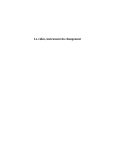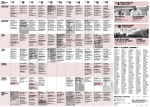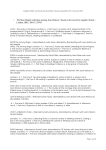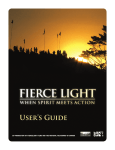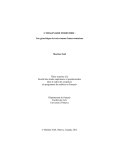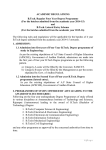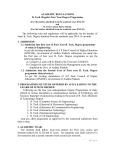Download USER GUIDE - National Film Board of Canada
Transcript
WRITER/DIRECTOR PEPITA FERRARI PRODUCER MICHELLE VAN www.nfb.ca/capturingreality A NATIONAL FILM BOARD OF CANADA PRODUCTION BEUSEKOM ©2009 NATIONAL FILM BOARD OF CANADA. PRINTED IN CANADA. PHOTO CREDIT: SANJAY METHA USER GUIDE USER GUIDE CAPTURING REALITY T HE A RT OF D OCUMENTARY Synopsis Capturing Reality is a double DVD set. The first DVD contains the 97-minute documentary film Capturing Reality: The Art of Documentary featuring 33 accomplished directors – including Albert Maysles, Errol Morris, Alanis Obomsawin, Michel Brault, Nick Broomfield, Kim Longinotto and that great iconoclast, Werner Herzog – sharing their insights of how they meet the challenges of making their documentary films. On disc 2 you will find four hours of Special Features: interview clips with the filmmakers featured in Capturing Reality as well as five additional interview subjects. Special Features can be screened either by topic area or by filmmaker and includes bios and filmographies. Both the documentary film and Special Features are arranged thematically to provide a chronological overview of the documentary filmmaking process – from why filmmakers make documentaries, to how they find their ideas, to how they work in the editing suite. The more than 160 clips found on the Special Features DVD can also be found on www.nfb.ca/ capturingreality. The Web site allows viewers to easily navigate by filmmaker or topic. Both the DVD and Web site include a basic biography and filmography for each director featured in the film. Capturing Reality: The Art of Documentary 1 Overview This user guide includes discussion topics and questions by key topic areas, by chapter and Special Features sections, as well as suggested activities by curriculum area. An “at-a-glance” chart is included in this guide and on the Web site to easily find filmmakers by topic. Capturing Reality is suitable for classroom use in secondary and post-secondary education, in subjects including film, video and digital media production; media literacy, literature and English courses; cinema studies; social studies; journalism; media and communications; and ethics. Capturing Reality is a rich tool to explore the most serious issues facing any creator of art about real life: • What story do I tell? the most effective way of telling it? • In what way do my choices about how to tell the story (Grierson’s notion of “the creative treatment of actuality”) make the final product an art form? • How do I honestly and openly face the inevitable ethical choices of telling a truthful story about something significant in real life? • What’s The film and Special Features will also allow your students to learn more about important documentary films and filmmakers of our time. Audience Age: Suitable for ages 16+. The films discussed and excerpted in Capturing Reality address important and sometimes grave or controversial issues of our time, such as animal slaughter, mental illness, poverty, torture and violence. In the Special Features section, filmmakers occasionally use some strong language. Educators are encouraged to preview the film and research background information to contextualize these situations when viewing the film in class. 2 Capturing Reality: The Art of Documentary FILM AND SPeCIAL FeATUReS, TOPICS: MAIN POINTS AND DISCUSSION QUeSTIONS You can enjoy Capturing Reality in an extended viewing or over several class periods. The film is neatly chaptered by topic so that you can also show selected segments (5 minutes long on average) in class. The Special Features permit you and your students to explore particular issues in depth. This section also suggests homework and extra credit assignments. (See Special Features chart on pages 16 and 17 for cross-listings of topics and filmmakers.) Following are some main points and possible discussion questions. Note: Main points and/or Discussion questions relating to the Special Features, Topics only are preceded by an asterisk.* 1 Becoming a Filmmaker Film – Chapter 1 (Special Features: getting Started: Becoming (Special Features a Filmmaker and Why Make Documentaries?) Main Points: Some go to film school, some don’t; some learn on the job, some stumble into it. For some people, documentaries are a creative challenge, for others it’s a way to enter other realities; for some it’s a way to share an experience, others want to correct the historical record or to expose an injustice. Discussion questions: How do people become documentary filmmakers? What kind of training and motivation do they have? Why do they choose to work in the genre of documentary? 2 what Is Documentary? Film – Chapter 2 (Special Features (Special Features: exploring the genre: What Is Documentary? The Social Role of Documentary, Cinéma verité: The Fly on the Wall and Influences) Main Points: Filmmakers see this form variously as a way of engaging audiences emotionally through a story about real life, as translated experience, as a painting. Filmmakers see documentary as an archive of human experience, a conversation, a provocation. Sometimes it expresses a personal voice, other times it makes a political statement. Cinéma vérité is a ubiquitous style, but not necessarily the road to “truth” and according to some, has limitations. *Certain documentarians have had a profound influence on other filmmakers. Capturing Reality: The Art of Documentary Discussion questions: What makes documentary films distinct from other genres? Is documentary an art form? Why do filmmakers enjoy making documentaries? What difference can a documentary make in the world? *Who do documentary filmmakers cite as major influences? 3 where Do Ideas Come From? Film – Chapter 3 (Special Features – Planning and Preparation: Preparation: Ideas & Inspiration) Main Points: Their own curiosity and personal engagement guide their search for stories and shape their themes. Sometimes the idea arrives unexpectedly; sometimes the filmmaker gives him/ herself a set of criteria and then looks for the idea to fit it. Discussion questions: What drives filmmakers to settle on a particular story or theme? How do they choose their stories? What makes them decide to commit to making the film? 4 Planning & Preparation Film – Chapter 4 (Special Features – Planning and Preparation: Preparation: Research and Structure & Approach) Main Points: Some documentarians find a theme or a through-line that guides their organization. Some work from well-defined scripts. Some simply look for opportunity while others do a huge amount of research before starting. In all cases, the resulting film has a defined structure that results from a 3 7 series of choices. *Some filmmakers have a very methodical approach to research while others just go on location and explore. The Art of the Interview Film – Chapter 7 (Special Features – Relationships: The Art of the Interview) Discussion questions: How do filmmakers prepare for making their films? How do they decide on the structure of their work? *What are some different approaches to the research phase? Does a documentary just evolve or do people write scripts in advance? Discussion questions: Should documentary filmmakers conduct formal interviews, engage in spontaneous conversations or stay quiet and simply capture what is happening before them? If they conduct interviews, is it fair to alter the environment? How can the subject’s environment influence the audience’s perception of them? What are some considerations that can influence an interview? 5 Casting From Real Life Film – Chapter 5 (Special Features – Relationships: Casting from (Special Real Life and Why People Talk to Cameras) Main Points: Choosing strong central characters with whom the director can establish a good rapport is critical. Some people forget themselves in front of the camera, while others are very aware of how they present themselves to the camera. *Some people have a strong motivation to share their stories on camera. Discussion questions: How do filmmakers select their main subjects and what kinds of qualities do they look for in them? How critical to the overall documentary is the choice of the central subject or character? How do people respond to the camera? 6 Director & Subject Relationship Film – Chapter 6 (Special Features – Relationships: Director & (Special Subject Relationship Relationship) Main Points: This is a central concern for documentary filmmakers. They establish an intense relationship with their subjects, which can be painful as well as intimate, and which influences the spectator’s experience. Discussion questions: How do filmmakers get their subjects to reveal themselves? How does the director-subject rapport translate to the screen? What is the filmmaker’s responsibility to a subject? 4 Main Points: Filmmakers disagree on the value of interviews and appropriate styles. Some conduct formal sit-down interviews while others have a more conversational approach or simply record life as it unfolds. Some conduct interviews in artificial environments, while others believe you should capture reality as it is. *Careful listening, patience and respect are key to obtaining good interview material. *Whether an interview subject has met the filmmaker beforehand can make a difference. 8 Truth: A Contested Notion Film – Chapter 8 (Special Features – Truth, Perspective & ethics: ethics: Truth) Main Points: Some filmmakers argue that all film is an artificial construction and they manipulate reality freely; others believe they must stay true to the facts; others believe that they are representing a deeper reality with their selection and manipulation of the real. Discussion questions: How do filmmakers decide what the best or most authentic representation is? Where is the line between artfulness and manipulation? Is it possible to tell the “truth” in a documentary? Capturing Reality: The Art of Documentary 9 ethics: Representing Reality Film – Chapter 9 (Special Features – Truth, Perspective & ethics: (Special Perspective and Ethical Issues) they or their crew should take? Think of different situations where obstacles filmmakers confront can be beneficial to the film. Main Points: Filmmakers disagree on the ethical obligation they have to their subject. Some think the subject’s wishes need to be honoured if there’s a good reason. Some think that telling the story is more important even if it might hurt the subject. Others defend their right to reveal insights from other cultures that may otherwise not be told or heard. *A documentary doesn’t reflect an objective truth but rather the perspective of the filmmaker. *Sometimes coming from another culture or reality can give a valid and different perspective. *It is almost unavoidable that the filmmaker’s presence and their camera will have some effect on the subjects. Access & Trust Film – Chapter 11 (Special Features – The Shoot: Getting Access) Access) Discussion questions: What should a filmmaker do if the subject doesn’t like how he/she is portrayed? What gives the director the right to tell someone else’s story—especially from across a cultural, class or other divide that separates powerful from less powerful people? Does a filmmaker have the right to make a documentary about a different culture/reality than their own and film people’s stories for the entertainment or education of his or her own society? getting the Shots Film – Chapter 12 (Special Features – The Shoot: Getting the Shots) Shots) 10 Risk & Adversity Film – Chapter 10 (Special Features – The Shoot: Handling Risk (Special and a nd Adapting to Circumstances Circumstances) Main Points: Both filmmakers and their subjects at times choose to take risks in making a film. The process of deciding whether to take the risk is often very different for each of them. Whether or not to take the risk needs to be carefully considered on both sides. Experiencing difficulties in making a documentary can be a good thing. 11 Main Points: Access is essential. It depends on establishing a relationship of trust, listening closely and asking the right questions. Sometimes it depends on persistence. Discussion questions: What are some ways a filmmaker can get access to their subjects and the story? Why might someone consent to allow a filmmaker to document aspects of their life? How can access change as the filming process moves forward? 12 Main Points: Different filmmakers use various approaches to recording events. Some let the camera be their eye experiencing the event. Others are very deliberate in how they frame and shoot events. Some directors believe the camera should not interrupt the exchange between the person shooting and their subject, while others find it can be used to provoke reactions productively. *Both technical and personal qualities make a good cameraperson. *Planning shots and sequences ahead is just as important as flexibility once the shoot is underway. Discussion questions: What kinds of visual information might a documentarian hope to get in their shot? How does the cinematographer decide what and when to film? How important is perspective when shooting? *What are some characteristics of a good cameraperson? Discussion questions: Up to what point is it all right for filmmakers to allow their subject to be endangered or place themselves at risk? How do documentary filmmakers assess how much risk Capturing Reality: The Art of Documentary 5 13 The Power of Images Film – Chapter 13 ((Special Special S pecial Features – The Shoot: The Power of Images) Main Points: Filmmakers constantly make aesthetic choices about how the film looks with light, photography and camera positions. *There are many layers of information that can be interpreted from images. *It’s important to decide whether or not film is the best medium to convey an idea. Discussion questions: How important is quality of the image? How do documentarians manipulate that quality? What tools do they have? What are the consequences of selecting where to put the camera? 14 Recreating Reality Film – Chapter 14 (Special Features – The Shoot: Recreating Reality) (Special Main Points: Some don’t like re-enactments, but others find them revelatory and vital to how they tell their story. The mixing of genres in today’s media creates confusion about what is supposedly “real” and what isn’t. Discussion questions: What are some of the reasons documentarians decide to use re-enactments and recreations? What ethical issues does the use of recreations raise? Is there a clear line between documentary and fiction? What does each genre have to offer the other? 15 Designing Sound Film – Chapter 15 (Special Features – Sound: Designing Sound) (Special Main Points: Recording good location sound will greatly affect the filmmaker’s options in postproduction. Sound can enrich and expand the image beyond what is on the screen. In the sound mix the filmmaker can make decisions about the parts they want us to hear. They make aesthetic choices about how the film sounds and may add in sound effects to enhance the viewer’s experience. 6 Discussion questions: What impact does capturing good location sound have on the film? How do filmmakers use sound to enhance the film? What kinds of alterations do they make afterwards to the sound they capture? What kinds of sounds might they add to the soundtrack? What are some motivations for adding new elements/layers of sound? 16 Music: enhancement or Intrusion? Film – Chapter 16 (Special Features – Sound: Music) Main Points: Some documentarians feel that music should not be used in documentary works but many filmmakers routinely add background and musical elements to deepen the meaning of the film. *A good dialogue between the filmmaker and the composer is pivotal to determining the film’s musical needs. *How well integrated music and image are in a film significantly affects the viewer’s experience. Discussion questions: How do documentarians use music in their soundtrack? Is soundtrack music justified in a film about real life? Are there times when music does not seem appropriate in a documentary film? *What are some ways the director and composer can discuss the music for a film? 17 Narration: A voice in your ear Film – Chapter 17 (Special Features – Sound: Narration) Main Points: Some filmmakers think narration impairs the experience; some think it’s a necessary evil to move the story forward; others think it can be a powerful aesthetic option. *Judging when and where to use narration is a delicate balance. Discussion questions: Should a documentary film have narration? Is narration a band-aid or a creative addition to a documentary? Capturing Reality: The Art of Documentary 18 Cutting Reality: The Art of editing Film – Chapter 18 (Special Features – editing: Director and Editor: (Special TThe he Relationship and Working with the Footage) Main Points: Editing requires working with the material collected and distancing yourself from the memory of what you had hoped to get before and during your shoot. It can be a long process and it is crucial to building the narrative thread of a documentary. Some filmmakers make changes in editing based on feedback from test audiences. Editing involves wrestling with ethical choices. There are many ways for the filmmaker and editor to work together. Discussion questions: What are some different approaches to putting a film together in the edit suite? How do filmmakers decide what should stay and what should go? How do filmmakers get feedback? Is editing an ethical as well as an aesthetic process? *What are some ways for the filmmaker and editor to work together? Capturing Reality: The Art of Documentary Ep Final Thoughts & Anecdotes Film – Epilogue (Special Features – Final Thoughts & Anecdotes: Anecdotes: Chris Marker to the Rescue, Anatomy of a Scene, Director as Immune System of the Film, A Confrontation of Fictions, The Importance of Experimentation and Filming: It’s a Relationship) Main Points: Documentarians sometimes want to change the world, sometimes they want to enjoy the world, sometimes they want to learn from it, sometimes they want to share their insights and experience about it. Changes in technology and the role of media are having a significant impact on people’s ability and desire to watch and to create documentaries. *Over time filmmakers develop their own vision of what documentary is to them. Discussion questions: What are some reasons filmmakers work so hard at something that is often difficult to make and ultimately may not be seen by many people? Do you think the general public’s interest in documentary is changing and if so, why? 7 Suggested Cross-Curricular activities (adaptable for all course subjects) Viewing with discussion. You can show Capturing Reality in its entirety and discuss it with your students. If you don’t have the time, or it isn’t appropriate to your course’s subject matter, you can assign the film for viewing outside of class and replay key chapters in class. You can also select key chapters in the film and/or the Special Features to trigger classroom discussion or show chapters in conjunction with a short documentary or short news clip of your choice. (You may also want to assign Special Features segments on the DVD or from the Web site as homework) Scenarios (case studies). Students can put themselves in the shoes of filmmakers facing an ethical, aesthetic or technical challenge after watching segments of Capturing Reality or select Special Features. Write scenarios that engage students—that are about their own lives, the places and people they encounter. Ask them to form small groups and to develop a position, exploring as well the reasoning behind it. Then spokespeople from the group can share the group’s results. In each situation, people may come up with different positions, as is clear from the film. Here are some suggested scenarios: •A fter watching film Chapters 1-2, 5-6, 8-9 and matching Special Features, Topics (see Film and Special Features section on pages 2-6 for related excerpts): You are making a cinéma vérité film about a year in high school (or college). One of your most important characters, it turns out, is one of the leading providers of illicit substances in the school. It’s a great story, and also it explains a lot about this character’s behaviour, friends and spending habits. Leaving it out would be lying about reality, and putting it in would put them at risk of legal prosecution. What do you do? •A fter watching film Chapters 1-3, 8, 14 and matching Special Features, Topics: You are making a documentary about a major corporation’s corrupt behaviour. You have audio, but you have no video for a crucial piece of evidence showing that the corporation’s employees understood full well what they were doing. You could run a generic background, you could use a collage of people’s faces, you could film people in shadow, silhouette, behind fog or in Rotoscoping doing the actions of the people heard on audio. What is the most responsible thing to do? •A fter watching film Chapters 1-2, 5-6, 8, 11 and matching Special Features, Topics: You have been working with an elderly quilt maker in your community about her life story, how she acquired her craft and what stories her quilts tell. But she is now failing, and her daughter doesn’t like you. The daughter tells you that you can’t film anymore and that you can’t use the material you’ve filmed so far. You think you have enough material to tell a good story. You have a release from the quilt maker, but the daughter says it’s not valid because she was already having memory problems when she signed it. What are the issues you are balancing, and what will you do? 8 Capturing Reality: The Art of Documentary Role-playing. Students can role-play different filmmakers around similar scenarios. For instance, on the question of whether re-enactment is appropriate, have 4 or 5 students assume the roles of filmmakers such as Errol Morris, Michel Brault, Werner Herzog, Jessica Yu, Nick Broomfield, Kevin Macdonald, Serge Giguère or Stan Neumann. You can also debate the question of whether interviews or voice-over narration is appropriate. Students might choose to play a male filmmaker (Jean-Xavier de Lestrade, Kevin Macdonald or Barry Stevens) while others play a female filmmaker (Jennifer Fox, Laura Poitras or Nettie Wild), and discuss the challenges around commitment to subjects. Note: This exercise will require a certain amount of research in order for the students to learn more about the particular filmmaker beyond what is covered in Capturing Reality. Both the DVD and the Web site provide a basic biography and filmography for each director featured in the film, which could be a good stepping stone for this exercise. Hold a debate. You can explore ethical, genre and aesthetic issues by way of a debate, in which one team must attack and one team must defend a position. In all cases, of course, there is no correct side. The goal is to bring to light typical one-sided arguments and then show why they are not adequate to the challenge of making honest and honourable documentary films. Divide the class in half. Ask the sides to meet to develop positions (reminding them that the job is to defend the position, not what they think is right), or more casually simply ask students to chat for a few minutes with their neighbours. Then ask one team to speak in defence of the position—informally, not according to debate rules, but using arguments from the film. Ask members of the other side to refute that position, using arguments from the film. Some debate topics might be: • Documentarians exploit people when they take their stories and use them to entertain other people. • A good documentary film should be able to let the characters and their conflicts tell the story; you shouldn’t need a narrator to tell you what you’re watching. • Documentaries are no more truthful than fiction films because filmmakers manipulate reality when they make their films. Capturing Reality: The Art of Documentary 9 Sample teaching modules for Media Production, Media Literacy, Cinema Studies, Ethics, Literature and Humanities, Social Studies and Journalism Here are some sample modules, organized by curriculum area for secondary school and early post-secondary studies. You can customize the modules or use them as a spur to your own invention. Depending on time and level of the course, you may want to supplement with or simply use or assign the Special Features segments on the DVD or Web site. Media Production/Media Literacy: Documentary filmmaking unit (4-8 hours) Goal: To integrate core questions encountered by filmmakers and showcased in Capturing Reality into student productions, with students seeing themselves as media creators with a range of choices to approach aesthetic and ethical issues. Method: Assign or watch the film in four units. The units could be divided as follows: Setting up the project: Chapters 1-2, 19, Special Features, Topics: Getting Started, Exploring the Genre, Planning and Preparation and Final Thoughts & Anecdotes. Relationships with subjects and selection of style: Chapters 5-8, Special Features, Topics: Relationships, and Truth, Perspective & Ethics: Truth. Ethics and risks: Chapters 9-11, Special Features, Topics: Truth, Perspective & Ethics: Perspective/ Ethical Issues, The Shoot: Handling Risk and Adapting to Circumstances and Getting Access. Elements of craft: Chapters 12-18, Special Features, Topics: The Shoot: Getting the Shots, the Power of Images, Recreating Reality, and Sound: Designing Sound, Music, and Narration and Editing. For each unit, students work on a short (3- to 5-minute) documentary. If you lack equipment, you can have them write a treatment—a step-by-step description of the film. People can work in small groups, or as a whole. Conclude the unit with a screening of work or, if a treatment, “pitch session” (a presentation of an idea for a film, with description, usually made to prospective funders, described well at http://www3.nfb.ca/ webextension/thepoint/students.php). Follow up with a discussion related to points made in Capturing Reality. At the end of the unit, students could be expected to upload and share their film on a Web platform such as YouTube or a school site. They could also post questions similar to the ones raised in the film about their own film on those sites. An important aspect of media literacy is the understanding that all media is constructed and that different people experience or express messages differently. If you wish to explore this aspect further, visit the Center for Media Literacy website, and ask students to deconstruct a short documentary, their own work, or the work of their classmates using the CML’s Five Key Questions. Suggestions for structuring the production assignment: Chose one or more topics yourself or in a brainstorm session with your students. Regardless of how you structure this (assigned topics by the teacher or chosen by students), students should make a film about something they know or are passionate about and that they can realistically produce within the confines of a school, classroom or local community. 10 Capturing Reality: The Art of Documentary Media Literacy/English/Cinema Studies: Genre--What defines a documentary? 1. Goal: To define the genre of documentary film using the actual experiences of filmmakers as shown in Capturing Reality and in the Special Features. Begin by a brainstorming session, asking fundamental questions such as: What is a documentary? What documentaries have you seen? What have you liked and disliked? View one or more short documentaries, for instance from the National Film Board of Canada, Quantum Shift, or Media that Matters Festival. (You could assign specific films or have students select and vote on the films to watch.) Discuss how this work fits the expectations and differs from those of the students. Apply the CML’s Five Key Questions to further explore and deconstruct the media at hand. Encourage students to research the filmmaker behind the film that they have just watched. What did they learn about this particular filmmaker? What would this filmmaker say in response to what is discussed in Chapters 1-5, 19 in the film and the relevant Special Features? As a class activity, students might pick a favourite director and discuss how this person would respond, providing rationale based on research and the content, technique and style of the film. 2. Goal: To understand that documentaries are made by individuals for a wide range of reasons, with a wide range of approaches. Nonetheless, they still work within a recognized genre of documentary film. Watch Chapters 1-5, 19 of Capturing Reality and relevant Special Features. Discuss how filmmakers think about their work and what a documentary is for them. How do their experiences differ from the students’ expectations before they watched? Briefly discuss differences between students’ attitudes about documentary before watching the film and after. Follow with Special Features excerpts from two contrasting filmmakers, for example Alanis Obomsawin, who has a clear social mission for her work, and Werner Herzog, who uses reality as a tapestry for his existential quest. Or you could compare Jennifer Baichwal and Errol Morris; both are driven to explore philosophical questions, but in different styles. Or compare Catherine Martin and Serge Giguère’s relationship with character and subject. Discuss how differently they define their task and how it affects the documentary that results. How are subjects and/or events treated differently by different filmmakers—for instance, directors with opposing points of view, directors from varying cultural, socio-economic and ethnic backgrounds, directors of varying age groups and by those with specific audience intentions (for instance a film for young people, a film for teachers, a film for television viewers)? As an activity, assign students a topic and have them write a description of two films, each told from a perspective represented by one of the filmmakers. Or simply ask them to deal with the same subject matter from two perspectives. Capturing Reality: The Art of Documentary 11 Literature/Cinema Studies: Storytelling 1. Goal: To investigate the range of narrative approaches in documentary film. First, view a short film, perhaps from NFB.ca, or another of your choice, and discuss with students what they understood to be the plot and the structure of the film. Ask who was telling the story, and how they knew that. Ask who the leading characters were. You can assign, in conjunction, the paragraphs associated with script in this helpful overview from A Danish Journal of Film Studies. (Editor: Richard Raskin, Number 13, March 2002. Department of Information and Media Studies. University of Aarhus) 2. Goal: To introduce the notion that films about real life involve choices about how to tell the story, and devices and approaches that parallel those in other texts. View Chapters 3-5, 7, 12-18 and, if time permits, the related Special Features segments. Discuss: • What narrative strategies do the filmmakers in Capturing Reality employ and why? • What design elements and aesthetic choices affect the storytelling? • How are stories told and how would this story be different if it were written in a book? A newsmagazine? A television program? On the news? • How does the format dictate the message? • What is required of the audience in each of these situations? • How does this requirement shape the impact of the message on the audience? (For instance, watching films on TV is a relatively passive activity while reading a book is an active process; news is often lacking context while watching a full film often provides context for a situation.) 3. Goal: To demonstrate the many tools and choices used by filmmakers in creating a story out of real-life material and characters. As an activity, have students imagine a film as a play, newspaper article, advertisement, book, magazine article or other mode of expression. 12 Capturing Reality: The Art of Documentary Social Studies/Journalism Some documentarians think of themselves as journalists; most, however, think of themselves as storytellers of significant and interesting aspects of real life. Capturing Reality can show how important public affairs issues are addressed in long form, storytelling mode. 1. Goal: To demonstrate the variety of ways that social issues can be covered and to show the impact of different expressive choices on what is told. Choose a current affairs topic that is touched upon in Capturing Reality, for instance, economic development in Africa (Darwin’s Nightmare, Hubert Sauper, or The Invisible Hand, Sylvain L’Esperance), human impact on the planet (Manufactured Landscapes, Jennifer Baichwal), disappearing ways of life (Pour la suite du monde, Michel Brault), transnational justice (The Pinochet Case, Patricio Guzmán), terrorism (One Day in September, Kevin Macdonald), indigenous rights (Kanehsatake: 270 Years of Resistance, Alanis Obomsawin), or the war in Iraq (My Country, My Country, Laura Poitras). Select a news segment, for instance from the Canadian Broadcasting Corporation (www.cbc.ca), and have students comment on the message and what was learned. Compare it with a short article from a national-level newspaper on the same general topic. 2. Goal: To raise for discussion the impact of form and style on delivery of information in daily journalism. Discuss the students’ expectations for what a documentary on such topics should look like. As a followup, show Chapters 1-3, 7-10, 17 and 19, with related Special Features if time permits. Discuss how these filmmakers approach the topics they address and how their choices differ from a journalist working for a newspaper, radio, TV or Web service. Discuss how the difference in time commitment to the topic the journalist or the filmmaker can make will affect the coverage the story gets. Capturing Reality: The Art of Documentary 13 ethics/Media Literacy (1-4 hours, depending on choice of options): The suggested activities explore the ethical challenges of telling something truthful about something in real life. Understand that all expression involves not only aesthetic but ethical choices. First, assign students to watch, or watch in class, Chapters 1-3, 5-9, 11 and 14 from Capturing Reality: The Art of Documentary. Then, assign students to watch, either as a group or out of class, one of the films discussed in the film. Assign or screen Special Features segments after the film screening. a 1. Goal: To raise & explore ethical choices in documentary film. a) For instance, you might use Standard Operating Procedure, Errol Morris’s documentary about the photographs taken in the Abu Ghraib prison in Iraq. Discuss: Do you agree with Errol Morris’s choices for portrayal of character, interviewing and re-enactment? What are the principles on which you found your support or disagreement? What would this film look like if it were told from someone else’s perspective (a victim, a government official)? Whose voice is absent or omitted from the film? Who did you want to hear from? Why do you think this voice was excluded – was it a question of access or of choice? From whose point of view is this story told? Do you feel that this person is well positioned to tell the story? Are there cultural, gender or class issues at play in this film and how the story is told? b b) You might choose instead to show a film by Alanis Obomsawin, for instance, Kanehsatake: 270 Years of Resistance (available free online at NFB.ca). Discuss: Should Obomsawin have spent more time showing the other side of the story? How did Obomsawin create interest in and empathy for the Mohawk activists? Was this fair? Why or why not? How does she use technique to reinforce her political position? Discuss the impact of technique on the audience (for instance, note the angle of view in representing the police, her narration, her positioning and representation of the opponents). Compare her film to media coverage of the standoff. How does it differ from what you can learn from watching the news? c c) You might, alternatively, choose Nettie Wild’s A Place Called Chiapas, which explores the movement for indigenous rights led by a left-wing Mexican scholar. Discuss: How does the film position the viewer? Does Wild, as a Canadian, have a right to make a film about civil rights struggles in Mexico? 14 Capturing Reality: The Art of Documentary Ethics/Media Literacy (1-4 hours, depending on choice of options): Continued 2. Goal: To understand the ethical challenges filmmakers (and other storytellers about real life) face, to see the range of approaches and attitudes and to discover common themes, for instance the developing of mutual respect between filmmaker and subject. Select, with the students, ethical challenges raised in the film, for instance those raised in the questions in Choice A. View, with the students, Special Features related to these questions – for instance, sections Relationships, Truth, Perspective & Ethics. Discuss the ethical grounds or principles that seem to inform the decisions that filmmakers make (even though they do not articulate them as such). Ask students how they arrived at these principles or reasons for the attitudes and actions of the filmmakers. Capturing Reality: The Art of Documentary 15 SPECIAL FEATURES BY FILMMAKER AND TOPICS Jennifer Baichwal ● al Is sues ● Michel Brault ● Nick Broomfield ● ● ● ● Joan Churchill ● Malcolm Clarke ● Eduardo Coutinho ● Paul Cowan ● ● ● ● ● ● ● Jean-Xavier de Lestrade ● ● ● ● ● ● Jennifer FoX ● Serge Giguère ● ● ● Denis Gheerbrant Patricio Guzmán Werner Herzog Pers pect ive Stru cture & Ap proa ch Cast ing F rom Real Life Why Peop le Ta lk to Cam Direc eras tor & Subje ct Re latio The nship Ar t o f the Inter view Truth ● Manfred Becker Molly Dineen TRUTH, PERSPECTIVE & ETHICS RELATIONSHIPS Ethic PLANNING & PREPARATION Idea s&I nspir ation Rese arch EXPLORING THE GENRE Beco ming a Fil mma ker Why Mak e Do cum enta ries? Wha t is D ocum enta r y? The Socia l Role of Do cum Ciné enta ma-V ry erité : The Fly o Influ n the ence Wall s GETTING STARTED ● ● ● ● ● ● ● ● Scott Hicks ● ● ● ● Heddy Hongimann Jean-Daniel Lafond ● Sylvain L’Espérance ● Jean Pierre Lledo ● ● ● Kim Longinotto Kevin Macdonald ● ● ● ● ● ● ● Catherine Martin ● ● ● Albert Maysles ● ● Errol Morris ● Stan Neumann ● Alanis Obomsawin ● ● ● ● ● ● Laura Poitras ● ● ● Emmanuel Priou Velcrow Ripper ● ● ● Hubert Sauper Rakesh Sharma ● ● Claire Simon ● Sabiha Sumar ● Nettie Wild ● Jessica Yu 16 ● ● ● ● ● Barry Stevens Peter Wintonick ● ● ● ● ● ● ● ● Capturing Reality: The Art of Documentary SPECIAL FEATURES BY FILMMAKER AND TOPICS Jennifer Baichwal ● ● FINAL THOUGHTS & ANECDOTES Thou ghts and Anec dote s EDITING Direc tor a n The Rela d Editor : tions hip Work ing w ith th e Fo otag e Narr ation Mus ic SOUND Adap ting to Cir cum stan ces The Powe r of I mag es Recr eatin g Re ality Desig ning Soun d Gett ing t he S hots Hand ling Risk Gett ing A cces s THE SHOOT ● Manfred Becker ● ● Michel Brault Nick Broomfield ● ● Joan Churchill ● Malcolm Clarke ● ● ● ● ● Eduardo Coutinho ● Paul Cowan ● Jean-Xavier de Lestrade ● ● Molly Dineen Jennifer FoX ● Serge Giguère ● ● Denis Gheerbrant ● Patricio Guzmán ● Werner Herzog Scott Hicks ● ● ● ● ● ● Heddy Hongimann ● Jean-Daniel Lafond ● Sylvain L’Espérance Jean Pierre Lledo Kim Longinotto Kevin Macdonald ● Catherine Martin ● Albert Maysles Errol Morris ● ● ● ● ● ● ● Stan Neumann ● ● Alanis Obomsawin Laura Poitras ● Emmanuel Priou ● Velcrow Ripper ● ● ● Hubert Sauper Rakesh Sharma ● Claire Simon ● Barry Stevens Sabiha Sumar Nettie Wild ● ● ● ● ● ● ● ● Peter Wintonick Jessica Yu Capturing Reality: The Art of Documentary ● ● 17 Related Resources Aufderheide, Patricia. Documentary Film: A Very Short Introduction (Oxford, 2007). Barnouw, Erik. Documentary: A History of the Non-Fiction Film (Oxford, 1973). Cunningham, Megan. The Art of the Documentary: Ten Conversations with Leading Directors, Cinematographers, Editors, and Producers (New Riders, 2005). Macdonald, Kevin and Mark Cousins, eds. Imagining Reality: The Faber Book of Documentary (Faber & Faber, 2006). Rabinger, Michael. Directing the Documentary (Focal Press, 2004). National Film Board Web site – www.nfb.ca Peter Wintonick, Cinéma vérité: Defining the Moment (National Film Board, 1999). Witness, Video for Change Training Guide (Pluto Press, 2005), also found at http://www.witness.org/index.php?option=com_content&task=view&id=277&Itemid=207 Visit the Capturing Reality Web site: www.nfb.ca/capturingreality for more related resources. User Guide Credits Written by Patricia Aufderheide, Director of the Center for Social Media at American University, Washington, DC in collaboration with Pepita Ferrari, writer/director of Capturing Reality: The Art of Documentary. NFB Project Leader: Susan Nosov NFB contributors: Veronica Barton, Kristine Collins, Dylan McGinty and Michelle van Beusekom Educational consultants: Elizabeth Miller, Susan Stranks, and Darrell Varga Copy editor: Nancy Barr Design and layout: Communication Malabar 18 Capturing Reality: The Art of Documentary






















